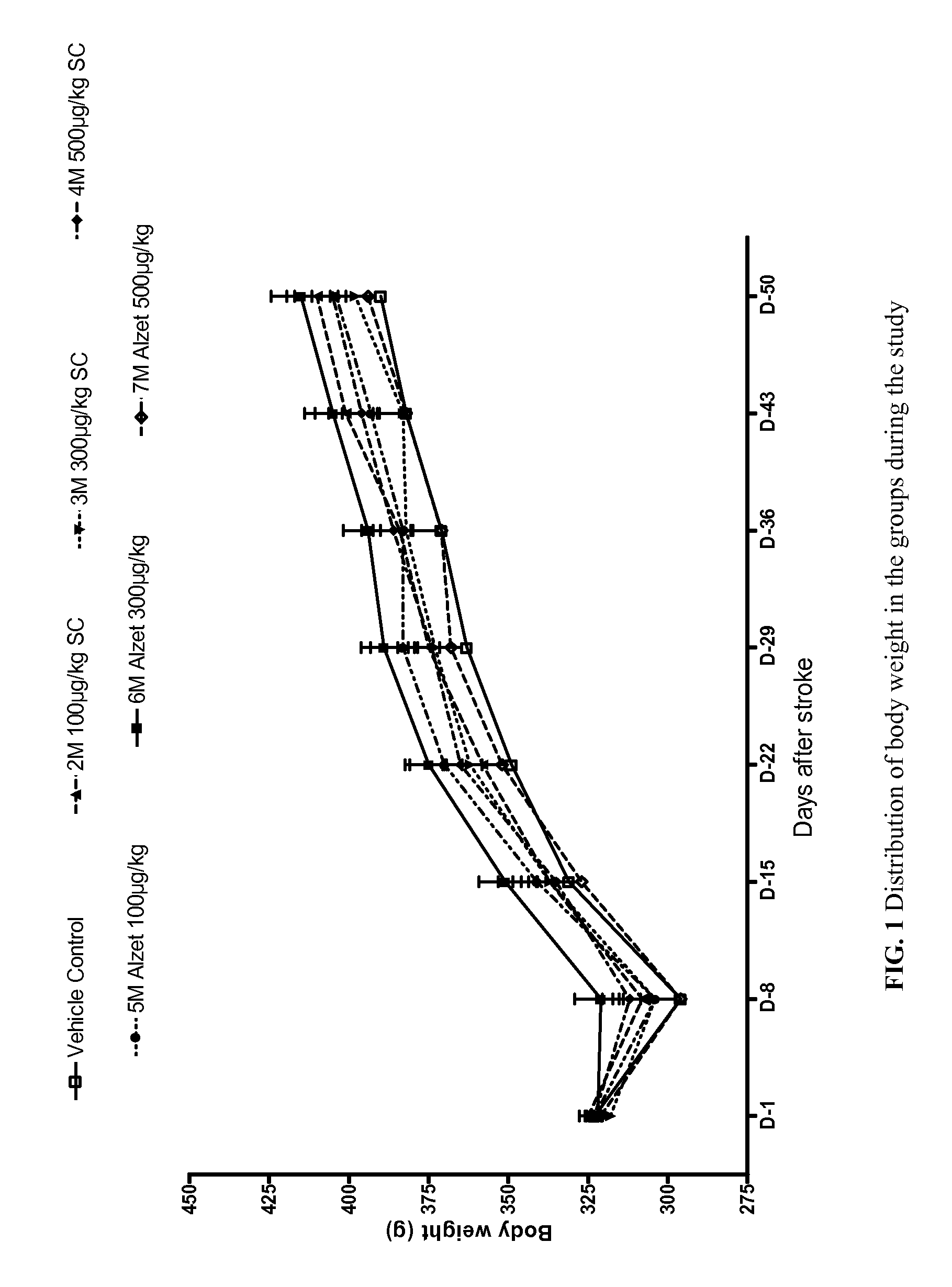Methods and compositions for the delayed treatment of stroke
a technology for delayed treatment and stroke, applied in the direction of drug compositions, peptides, peptides/protein ingredients, etc., can solve the problems of progressively worse outcomes, and achieve the effects of increasing protease resistance, serum stability and/or bioavailability
- Summary
- Abstract
- Description
- Claims
- Application Information
AI Technical Summary
Benefits of technology
Problems solved by technology
Method used
Image
Examples
example 1
Delayed Treatment of Stroke with TXA127 (SEQ ID NO: 1)
[0224]In this Example, angiotensin (1-7) peptides were used in a rat Transient Middle Cerebral Artery Occlusion (tMCAO) model, which is generally accepted model of ischemic stroke.
[0225]Specifically, a total of 105 Sprague Dawley rats were used, as seven groups with 15 rats in each. Each rat was approximately 3 months old and weighed approximately 300 grams±20% at the initiation of the study.
[0226]Animal handling was performed according to the guidelines of the National Institutes of Health (NIH) and the Association for the Assessment and Accreditation of Laboratory Animal Care (AAALAC). Animals were fed ad libitum a commercial rodent diet, had free access to drinking water, and were housed under standard laboratory conditions with a 12 hour light / dark cycle.
[0227]In this Example, the day of the tMCAO procedure is defined as “Day 1” of the study.
[0228]TXA127 (SEQ ID NO: 1) dose volume was 0.5 ml / kg for daily injections. TXA127 wa...
example 2
Delayed Treatment of Stroke with TXA302 (SEQ ID NO: 2)
[0262]In this Example the angiotensin (1-7) peptide TXA302 (SEQ ID NO: 2) was used in the rat Transient Middle Cerebral Artery Occlusion (tMCAO) model of stroke to determine the effects of this peptide weeks after a stroke event.
[0263]In this Example, a total of 30 Sprague Dawley rats were used, evenly split into two groups with 15 rats in each. Each rat was approximately 3 months old and weighed approximately 300 grams±20% at the initiation of the study.
[0264]As in Example 1 above, animal handling was performed according to the guidelines of the National Institutes of Health (NIH) and the Association for the Assessment and Accreditation of Laboratory Animal Care (AAALAC). Animals were fed ad libitum a commercial rodent diet, had free access to drinking water, and were housed under standard laboratory conditions with a 12 hour light / dark cycle.
[0265]In this Example, the day of the tMCAO procedure is defined as “Day 1” of the stud...
example 3
Delayed Treatment of Stroke with TXA127 (SEQ ID NO: 1) or TXA302 (SEQ ID NO: 2)
[0287]In this Example, two angiotensin (1-7) peptides, namely, TXA127 (SEQ ID NO: 1) and TXA302 (SEQ ID NO: 2) were used in the rat Transient Middle Cerebral Artery Occlusion (tMCAO) model of stroke to establish dose responses and to determine the comparative effects of these peptides when administration first begins four weeks after a stroke event.
[0288]In this Example, a total of 120 Sprague Dawley rats were used, evenly split into eight groups with 15 rats in each. Each rat was approximately 3 months old and weighed approximately 300 grams±20% at the initiation of the study.
[0289]As in Examples 1 and 2 above, animal handling was performed according to the guidelines of the National Institutes of Health (NIH) and the Association for the Assessment and Accreditation of Laboratory Animal Care (AAALAC). Animals were fed ad libitum a commercial rodent diet, had free access to drinking water, and were housed...
PUM
| Property | Measurement | Unit |
|---|---|---|
| Time | aaaaa | aaaaa |
| Time | aaaaa | aaaaa |
| Time | aaaaa | aaaaa |
Abstract
Description
Claims
Application Information
 Login to View More
Login to View More - R&D Engineer
- R&D Manager
- IP Professional
- Industry Leading Data Capabilities
- Powerful AI technology
- Patent DNA Extraction
Browse by: Latest US Patents, China's latest patents, Technical Efficacy Thesaurus, Application Domain, Technology Topic, Popular Technical Reports.
© 2024 PatSnap. All rights reserved.Legal|Privacy policy|Modern Slavery Act Transparency Statement|Sitemap|About US| Contact US: help@patsnap.com










